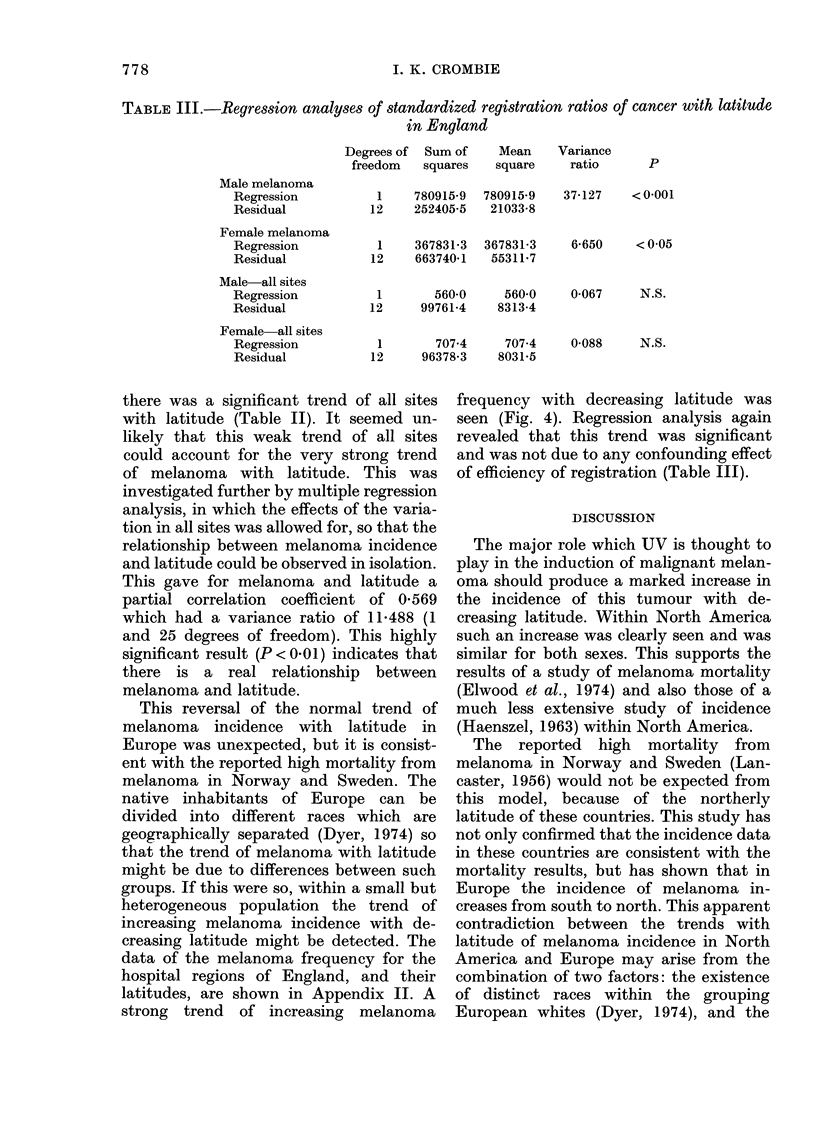Abstract
The relationship between melanoma incidence and latitude was investigated in North American and Europe, using the data collected by 43 population-based cancer registries. In North America melanoma incidence increased with decreasing latitude, supporting the role of UV light in the induction of melanoma. Within England the data from the National Cancer Registration scheme also showed that trend of decreased frequency of melanoma with decreasing latitude. In contrast, across Europe the trend was in the opposite direction, of increasing melanoma incidence with increasing latitude. It is suggested that across Europe there is a range of skin colour from dark in the south to light in the north, which gives rise to a range of susceptibility to the induction of melanoma by UV. The effect of this susceptibility must be large enough to overwhelm the opposing effect of decreased UV intensity at higher latitudes, and this emphasizes the dangers of excessive solar exposure to fair-skinned individuals. The populations of England may be a sufficiently random mix of skin colour, owing to repeated invasions, for the effect of UV intensity to be observed.
Full text
PDF







Selected References
These references are in PubMed. This may not be the complete list of references from this article.
- Camain R., Tuyns A. J., Sarrat H., Quenum C., Faye I. Cutaneous cancer in Dakar. J Natl Cancer Inst. 1972 Jan;48(1):33–49. [PubMed] [Google Scholar]
- Crombie I. K. Racial differences in melanoma incidence. Br J Cancer. 1979 Aug;40(2):185–193. doi: 10.1038/bjc.1979.165. [DOI] [PMC free article] [PubMed] [Google Scholar]
- Elwood J. M., Lee J. A., Walter S. D., Mo T., Green A. E. Relationship of melanoma and other skin cancer mortality to latitude and ultraviolet radiation in the United States and Canada. Int J Epidemiol. 1974 Dec;3(4):325–332. doi: 10.1093/ije/3.4.325. [DOI] [PubMed] [Google Scholar]
- Fears T. R., Scotto J., Schneiderman M. A. Mathematical models of age and ultraviolet effects on the incidence of skin cancer among whites in the United States. Am J Epidemiol. 1977 May;105(5):420–427. doi: 10.1093/oxfordjournals.aje.a112400. [DOI] [PubMed] [Google Scholar]
- Gellin G. A., Kopf A. W., Garfinkel L. Malignant melanoma. A controlled study of possibly associated factors. Arch Dermatol. 1969 Jan;99(1):43–48. doi: 10.1001/archderm.99.1.43. [DOI] [PubMed] [Google Scholar]
- LANCASTER H. O., NELSON J. Sunlight as a cause of melanoma; a clinical survey. Med J Aust. 1957 Apr 6;44(14):452–456. [PubMed] [Google Scholar]
- LANCASTER H. O. Some geographical aspects of the mortality from melanoma in Europeans. Med J Aust. 1956 Jun 30;43(26):1082–1087. [PubMed] [Google Scholar]
- Lee J. A., Yongchaiyudha S. Incidence of and mortality from malignant melanoma by anatomical site. J Natl Cancer Inst. 1971 Jul;47(1):253–263. [PubMed] [Google Scholar]
- Magnus K. Incidence of malignant melanoma of the skin in Norway, 1955-1970. Variations in time and space and solar radiation. Cancer. 1973 Nov;32(5):1275–1286. doi: 10.1002/1097-0142(197311)32:5<1275::aid-cncr2820320537>3.0.co;2-8. [DOI] [PubMed] [Google Scholar]
- Magnus K. Incidence of malignant melanoma of the skin in the five Nordic countries: significance of solar radiation. Int J Cancer. 1977 Oct 15;20(4):477–485. doi: 10.1002/ijc.2910200402. [DOI] [PubMed] [Google Scholar]
- Quevedo W. C., Fitzpatrick T. B., Pathak M. A., Jimbow K. Role of light in human skin color viariation. Am J Phys Anthropol. 1975 Nov;43(3):393–408. doi: 10.1002/ajpa.1330430321. [DOI] [PubMed] [Google Scholar]


